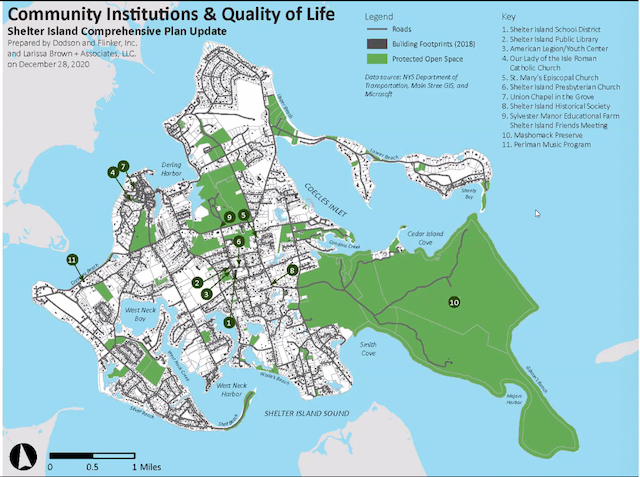
Ask any kid applying to college what’s the hardest part of the process and you’ll elicit groans about the essay. Turns out, it’s actually very hard to write about yourself. But crafting an Island self-portrait is just the first of many challenges facing the 12 members of the Town’s Comprehensive Plan Advisory Committee.
An early step in the year-long planning process is defining Shelter Island as it is today, a task that currently takes the form of a 100-page draft report that committee members are reviewing and refining over the next few weeks.
Like student essayists, they’ll want to describe what they’re proud of, but not brag; point out flaws, but not throw anyone under the bus; and explain how where we are can help get us to where we want to be.
CPAC meets again on Monday, February 1 at 7 PM via Zoom. For login details, send an email to cthuman@shelterislandtown.us.
Change in staff
At the committee’s most recent meeting and before getting to the heart of the task, Project Director Edward Hindin announced there’d been a staffing change in the consulting team. Peter Flinker, of the firm Dodson & Flinker, said Lisa Liquori, of the East Hampton firm Fine Arts & Sciences LLC, had to withdraw from the project for health reasons.
Flinker reached out to Larissa Brown, principal of the planning firm Larissa Brown & Associates LLC of Cambridge, MA. The’ve worked on numerous comprehensive planning projects, he said. Brown’s online bio describes a long career in planning with expertise at “helping communities become more livable, equitable, sustainable, and resilient through holistic planning and strategic advice.”
“In my experience with comprehensive plans, the ones that are successful are when the committee in charge becomes the champion and that the people in the community see this as the community’s plan, not the consultants’ plan,” Brown said.
Drafting an Island self-portrait
The Shelter Island 2020 report — which sets the groundwork for future planning — will have 12 major elements. Each of the 12 CPAC volunteers are working on three elements, and coordinating the activities of one group (marked with *):
- People of Shelter Island (Lily Hoffman. Rebecca Mundy*, Wendy Turgeon)
Land Use & Zoning (Benjamin Dyett, John Kerr, Meg Larsen*) - Natural Resources & Environment (Jay Card, Kerr*,Larsen)
- Historical & Cultural Resources (Hoffman*, Jo-Ann Robotti, Petra Schmidt)
- Economic Development (Kathleen DeRose, Schmidt*, Turgeon)
- Housing (Sean Clark*, Dyett, DeRose)
- Transportation & Mobility (Peter Bearsley*, Card, Robotti)
- Community Services & Facilities (Beardsley, Mundy, Turgeon*)
- Infrastructure & Utilities (Card*, Kerr, Schmidt)
- Public Health and Safety Services (Clark*, Dyett, Hoffman)
- Community Institutions & Quality of Life (Clark, Mundy, Robotti*)
- Governance (Beardsley, DeRose*, Larsen)
As they review the draft, the consultants said the volunteers should keep these questions in mind: What are the key things Islanders need to know in order to support good decisions? What are people going to object to? What kind of information is it best to have at the outset of the project?
[Note: Learn more about the committee members in our post from the first meeting in December.]
People of Shelter Island
Figuring out how many people call Shelter Island home is complicated even though it’s a relatively small place, Brown said. How many are year-round residents? How many are seasonal? What are the trends? How many have gone from seasonal to full-time due to the pandemic? Will they remain once pandemic restrictions ease?
The consultants came up with a base population of 2,500, with 3,000 current full-time residents partly due to COVID. The population, Brown said, is 90 percent white — with a small but growing number of Hispanic residents — generally older, very well educated, and affluent.
Most households have no children at home. The consultants looked at old census data (2020 figures are still a long way off), assessment rolls, school enrollment, voter registration, real estate transactions, short-term rental data, and more.
Clark, a Shelter Island police officer, suggested asking PSEG-LI for electricity usage data that the utility uses to estimate household size. Brown said the committee might also consider contracting for a review of mobile device data.
Land Use & Zoning
Flinker shared some draft maps that showed Shelter Island land use patterns over time, evolving from past rural, agrarian uses to today’s patchwork of residential, commercial and preserved open space.
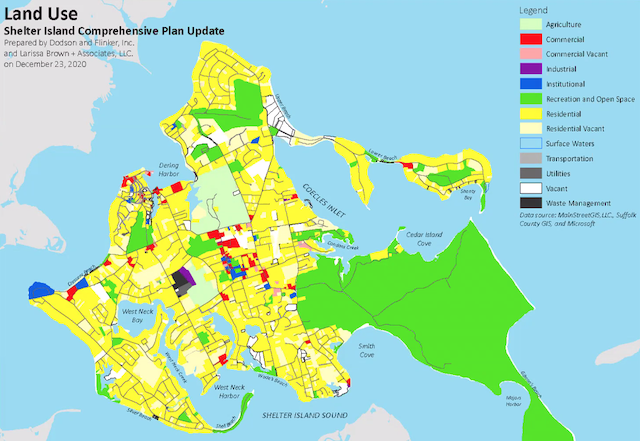
The consultants are trying to work out which lands identified as vacant could actually support development — not too wet, not too dry, have sufficient road frontage, etc. — for a better sense of what the Island could look like at full buildout and indicate how zoning rules might be tightened or relaxed to guide development.
Committee members suggested numerous insider corrections to the maps, particularly relating to open spaces. Dyett, a member of Sylvester Manor’s Board of Trustees (where he served until recently as president) pointed out that the 240-acre property, while open to the public, is not a public park but is a privately-owned and operated by a nonprofit. While large portions of the property are governed by agricultural and open space easements, much of the land is unencumbered by deed restrictions.
Likewise, Kerr, a member of the Town’s Conservation Advisory Council, noted that the 2,039-acre Mashomack Preserve is also not a public park, but is privately-owned. Should The Nature Conservancy choose to sell, the land might be developed for a variety of purposes. “It isn’t sacrosanct as park area,” he said.
Flinker pointed out that a community’s collective desire to preserve open space exerts upward pressure on land values, making it both more expensive to build and more expensive to conserve additional land.
On Shelter Island, the lack of public water and sewer systems limit overall growth. Along with zoning restrictions, this drives development along a decidedly suburban path, Flinker said. That’s a trend away from the Island’s early days of homes clustered together in small neighborhoods.
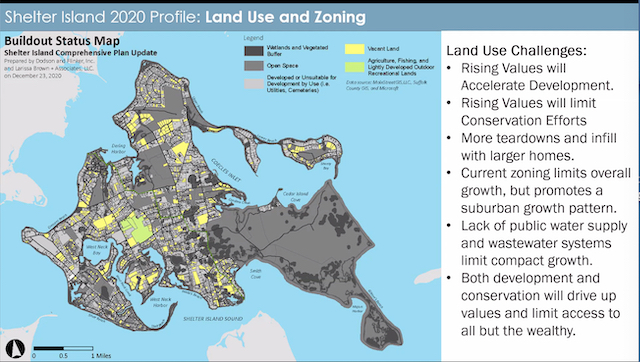
Flinker forecasts more tear downs and small homes being replaced by larger structures.
“Supply and demand means everything is going to get more expensive here and perhaps in 50 years you’re going to look like places you don’t want to look like, where ordinary people can’t afford to live,” he cautioned.
Natural Resources & Environment
The Island’s natural resources and environment are probably the best studied aspects of the plan, Flinker said. “We have lots and lots of good information.”
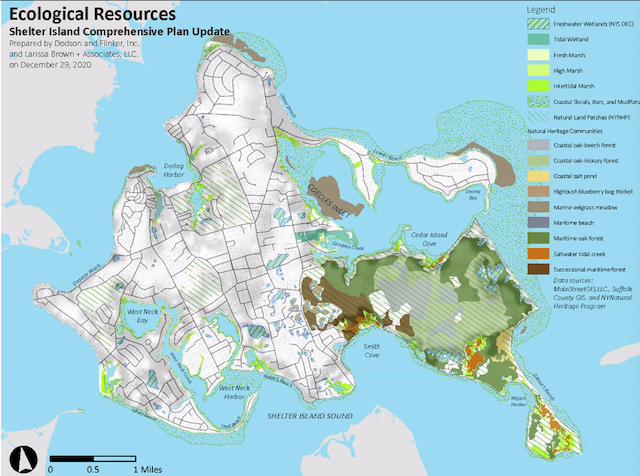
Among the most important, and potentially most controversial resources is fresh water. Flinker noted it “impacts so many other aspects of the plan moving forward.”
Both quantity and quality have been examined, and it’s important to express clearly to the community what the findings are and how they may influence development into the future.
Sea-level rise is another critical factor for the Island, as is the need to balance recreational demand on natural areas with protection of ecosystems, he said.
“There will be lots of changes along the coast that will be difficult to deal with,” Flinker said.
DeRose noted that while fresh water quantity appears to be sufficient for the Island as a whole, certain areas of the Island already lack potable water. Jay Card asked for a closer look at salinity of various levels in the aquifer that provides Shelter Island’s drinking water.
Dyett said it was important to look for innovative solutions. “Trying to do things the way they’ve always been done usually doesn’t get you anywhere.”
Historical & Cultural Resources
In this section, the consultants map out the Island’s numerous historical and cultural resources, including the 10 National Historic Register sites.
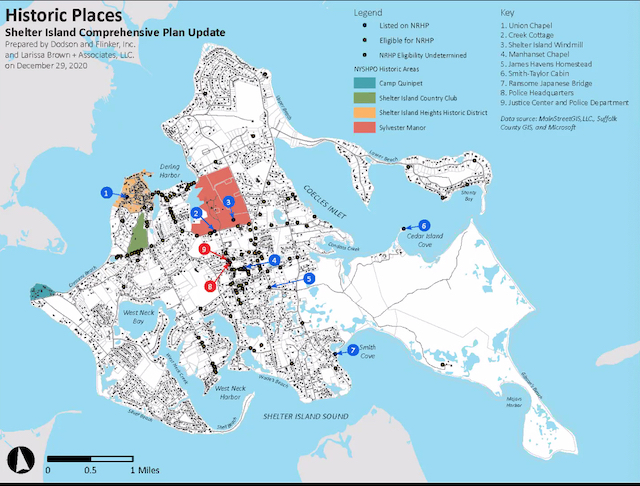
Among the highlights are Shelter Island Historical Society’s Havens House campus, Mashomack Preserve, Sylvester Manor Educational Farm, the Shelter Island Heights Historic District, Quinipet Camp & Retreat Center, and Shelter Island Country Club.
Flinker said one challenge to preserving historical assets is there is nothing in Town Code to prevent tearing them down.
“How can we understand the larger landscape that’s not traditionally considered part of the historic resource but is really key to character and quality of life on the Island,” Flinker asked.
“What parts of the Island do we really need to think about in terms of that larger vernacular landscape of ordinary houses that aren’t historic … or landscapes that people know and love because they’re part of the history and culture of the Island?”
Hoffman, a member of the Historical Society Board of Directors, said the Society maintains a house registry and could provide key insights. However, she noted that the pandemic has cut off cultural institutions from their two most important resources — volunteers and donations.
“We’re talking about institutions that are hard stressed … with no viable fundraising events.”
Economic Development
Regarding economic development, Brown said it will be essential to determine the community’s hopes for what is essentially a tourism economy with a very small year-round market. About 23 percent of businesses and 31 percent of Island jobs are tourism-related. The local workforce includes 1,000 to 1,300 residents working in jobs on and off the Island.
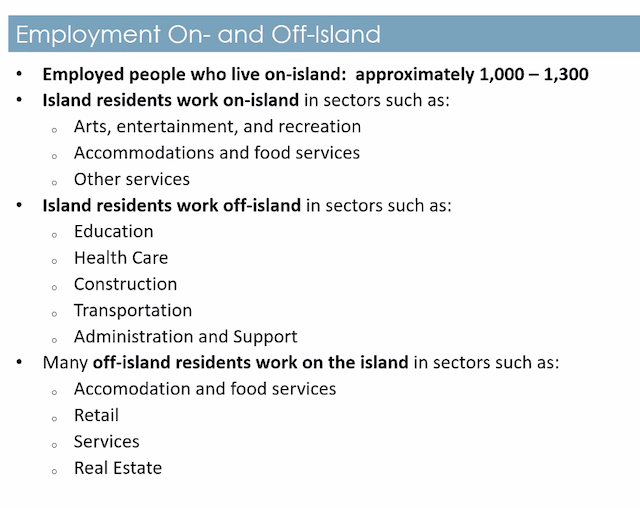
Questions to tackle include: How much more development will Islanders support in order to enhance economic activity? While the Heights offers a walkable retail area, the Center is more car-centric. Are there changes the community might consider to attract businesses and diversify the economy?
“I didn’t see in anything that I read that there’s any clear approach to this on the part of the Town, or goals or strategies for the Island economy,” Brown said. “Now’s the time to think about what do we really want from this.”
Schmidt suggested looking at comparable communities with similar seasonal economies. Smith said they had, but that it’s difficult to find truly comparable comps. While Block Island, Nantucket and Martha’s Vineyard have many similarities, they differ from Shelter Island particularly in proximity to neighboring communities. The three “comps” are genuinely isolated but Shelter Island is “an island you can get off of in 10 minutes,” she said. “It really is unusual in many of its characteristics.”
Dyett suggested the consultants also look at nearby communities to see how they managed development over time. Hoffman pointed out the enormous changes wrought by the pandemic that impact so many aspects of life, including shopping habits.
Housing
Divining an accurate profile of housing also poses challenges. Reliable data show a majority of homes are owner-occupied. More than half are owned by people with off-Island addresses, Brown said. The consultants will also look at construction trends, including building permit records and demolition data.
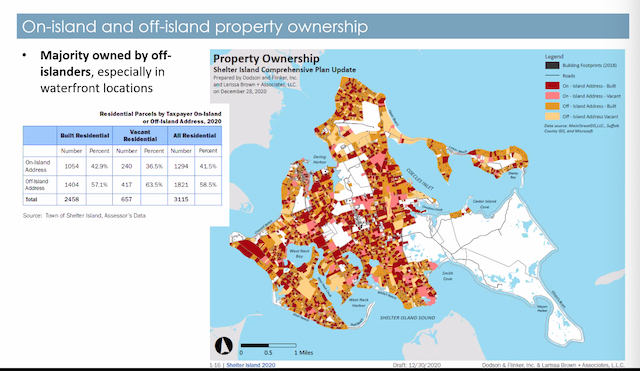
About housing in general, Brown said, “Guess what? It’s very expensive, as you all know.”
This is particularly true of waterfront and water view homes, she said. While there are anecdotal reports of more transactions than expected during the pandemic, the official data lag by about six months. Median sales price in 2020 was nearly $1 million, Brown said.
Importantly, the cost of housing will impact the committee’s discussions about how the Town might provide attainable housing (to use the committee’s preferred term). When thinking about the future of such a program, she said it’s important to determine “is it for workers? Is it for families? Who is it for, and what does that mean?”
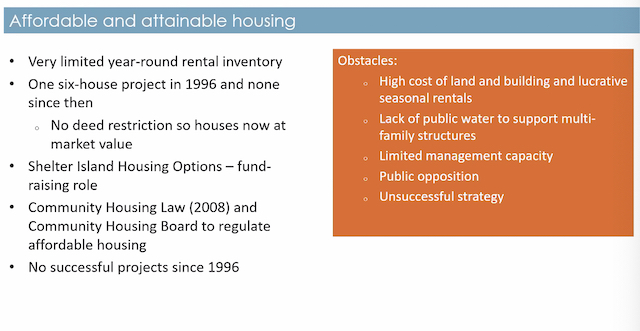
The Town’s past affordable housing project was “not particularly successful,” Brown said. Failure to put deed restrictions on houses sold via a lottery means they quickly converted to market-value.
“It’s not clear from what I’ve read what people are imagining would happen in terms of management, especially if you’re building rental housing,” Brown said.
Clark said he’d like to look into Town-sponsored rental assistance and down payment grants and other incentives in use in Southampton and East Hampton.
Brown said that while lack of public water and sewer is a big impediment to producing multiple rental units, the Island might also look at setting up a community land trust, and other ways to leverage resources for attainable housing.
Transportation & Mobility
The consulting team mapped out daily traffic patterns, using state traffic data. And they identified several transportation and mobility challenges. Numerous roads are subject to flooding, which will increase with sea-level rise. While biking is a desirable use, narrow roads with no designated bike lanes lead to conflicts between cyclists and drivers, sometimes resulting in crashes.
Likewise, minimal sidewalks and narrow shoulders make it hard for some residents to walk safely between their homes and work or other local destinations. And some roads may not be designed to handle the increasing size and weight of heavy trucks, possibly requiring upgrades that could alter their character.
How do you expand the capacity for sharing the relatively narrow roads, Flinker asked, that are lined with things you want to protect, like trees, that contribute to the feel of the Island?
The North and South Ferry landings — the Island’s only connections with Long Island and beyond to the mainland — will be especially impacted by rising sea levels.
Card asked that motor vehicle accident figures be included in the discussion of transportation, including deer vs car crashes. Committee members agreed that everyone is aware of problems posed by interactions with the Island’s large deer herd. Including the data can lend support to deer management initiatives, Card said.
Community Services & Facilities
Brown walked the committee through a draft map that shows community services and facilities, as well as land that belongs to governmental bodies (the Town, Village of Dering Harbor, Suffolk County and New York State).
The big hubs — the Shelter Island School and Shelter Island Public Library — are technically not part of the Town government, Brown said.
While school enrollment generally had been declining, it increased this year as families moved out to escape pandemic closures elsewhere. The school is well-funded and enjoys strong support from taxpayers, as well as from the nonprofit Shelter Island Educational Foundation. More data was forthcoming.
The Shelter Island Public Library “seems to be a successful small town public library,” Brown said. Governed by a board and supported by a tax levy, it also enjoys the support of a well-funded Friends of the Library organization.
“I see both of these institutions in a lot of ways as being places the community has decided it wants to invest in and wants to keep that investment up,” Brown said.
The Town itself owns about 25 buildings and operates the West Neck Water District. She pointed out numerous successes in operations and management of Town facilities, its roads and vehicle fleets. The Town’s solid waste management program “seems at least as far I tell is a big success.”
For such a small place, the Town’s recreation options are impressive, Brown said, although programs are closed due to COVID. Past Recreation Department calendars show a schedule of programs aimed at various age groups, with lots of “things for people to do if they’re interested.”
One area of weakness, Brown said, was the lack of a multi-year capital plan and a modern asset management program. “In both cases, although it takes a little to work to set it up, … ultimately it could help Town government be more cost efficient and basically manage its assets better.”
There is also a need to create a capital reserve fund.
Infrastructure & Utilities
For a tourist economy rooted in shoreline access, Flinker said, the Town’s infrastructure and utilities contribute in key ways to the community’s well-being.
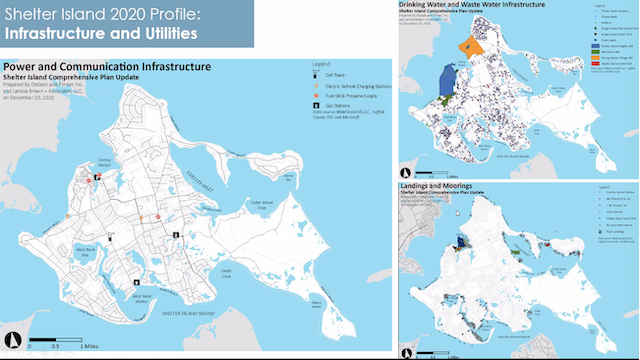
The draft report includes an inventory of power and communications infrastructure including cell towers, electric vehicle charging stations, fuel oil and propane supply, and gas stations. There is a map of drinking water and wastewater infrastructure, including septic systems and stormwater runoff basins. Another map shows public landings and mooring fields.
Card, who served for many years as Highway Superintendent and of Public Works, said he’d want to look closely at the maps to ensure they included the most recent cell towers, stormwater structures and other recent improvements.
Card also noted problems with WiFi around the Island. DeRose said the cable company that provides most internet access has spotty coverage, which may serve to inhibit business growth.
Public Health and Safety Services
“For a small community, Shelter Island had really done a pretty good job of trying to figure out how to provide medical services, connect people to those medical services that the Town itself doesn’t have, and to provide emergency medical services,” Brown said.
The Town Medical Center houses the offices of two physicians representing different medical organizations. Other medical providers — a chiropractor and dental group — have offices on the Island. What’s more, Shelter Island is surrounded by “a huge medical infrastructure on the North and South Forks and throughout Suffolk County,” Brown said.
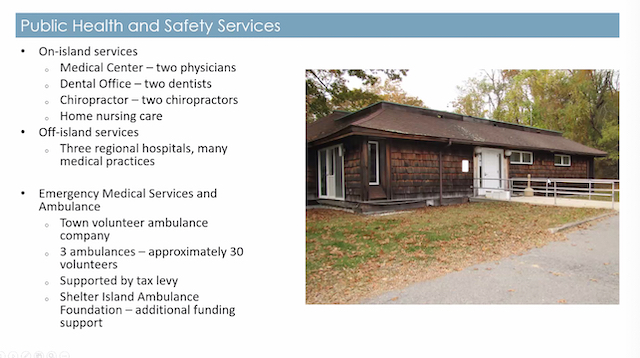
The 30-member volunteer Emergency Medical Services team gets some tax levy funding and benefits from the fundraising efforts of a dedicated nonprofit foundation; both are indications that residents largely support the EMS, Brown said.
The Town also offers a robust Senior Services program, she said. But it’s important to consider whether the population will continue to skew toward seniors, and how the Town might meet future demand for services.
While tick-borne diseases represent a major health threat, Brown said, that’s true for much of the New York Metropolitan Region. “It’s nothing that’s peculiar to Shelter Island.”
The Town also has a robust public safety program, with an accredited police department, “They’re well trained, well supported,” Brown said.
The 77-member volunteer fire department seems also to be doing well, but as with EMS, the continued reliance on volunteers can prove problematic, especially with an aging population and rising costs of living.
Community Institutions/Quality of Life
Churches, schools, libraries and other community institutions strongly impact quality of life, particularly in a small town like Shelter Island. Flinker mapped out local entities “that provide the cultural life of the town and support the social life of the town.”

He noted that ongoing demographic change “is making it harder to support a lot of these institutions.”
“We’ve heard a lot already about how the negative impacts of growth, which might be good for economic development, are not always good for quality of life and support for these institutions,” he said.
“Some of the small town traditions of neighborliness are changing as people come in who aren’t as familiar with those institutions and don’t support them necessarily,” he said, asking, “How do we balance diverse needs across the demographic and economic spectrum, especially as property values continue to rise?”
Mapping out the structure of the community is one of the biggest challenges facing the committee, Flinker said. “How does it work? How did it work in the past? How could it work in the future? How do we hold onto the big institutions which produce the quality of life you enjoy?”
Governance
In terms of technical capacity, Brown said the Town has a small government staff. But in areas where the Town lacks in-house technical support — such as land use, planning and economic development — it seems willing to use consultants.
The Town relies heavily on committees to cover regulatory, management and advisory functions. CPAC might look at ways to separate some of those functions and improve efficiency.
Communications could also be improved, Brown said. A look at meeting minutes and website content shows, “There are varying levels of transparency and public information.”
“In Towns that are run by volunteers there can be this proliferation of committees,” she said. “In doing this Comprehensive Plan this a time to think about what do we need committees to do. Again, there’s this whole issue of being able to attract volunteers to work on the committees. A little bit of efficiency might be a good thing.”
Shelter Island’s high voter turnout is a sign of “a community that’s paying attention to what’s going on,” Brown said.
The Town Code seems due for an overhaul, she said. It was last codified 40 years ago, and additions and deletions since then can make for a confusing read. “Maybe its not as efficient as it could be. You want to have regulation that’s effective, that protects the public interest but also is as efficient as you can make it.”
It is common after a Comprehensive Plan is completed, she said, to go back and make sure the Town Code “actually is working so that we can achieve the goals we decided we wanted.”
Next meeting February 1
The Comprehensive Plan Advisory Committee meets again Monday, February 1 at 7 PM via Zoom. According to the agenda, members will review suggested changes to the draft Shelter Island 2020 report; consider proposed questions for a community survey, and share feedback they’ve head from the community, among other tasks.
[Editor’s note: This post was moved up in our news queue and updated to include a link to the February 1 meeting agenda.]




